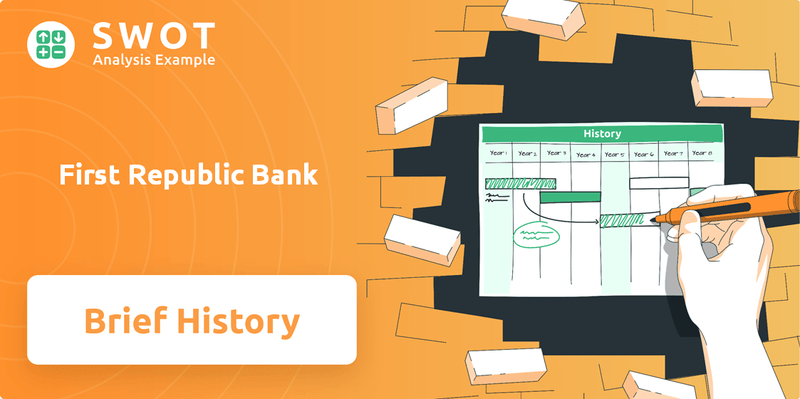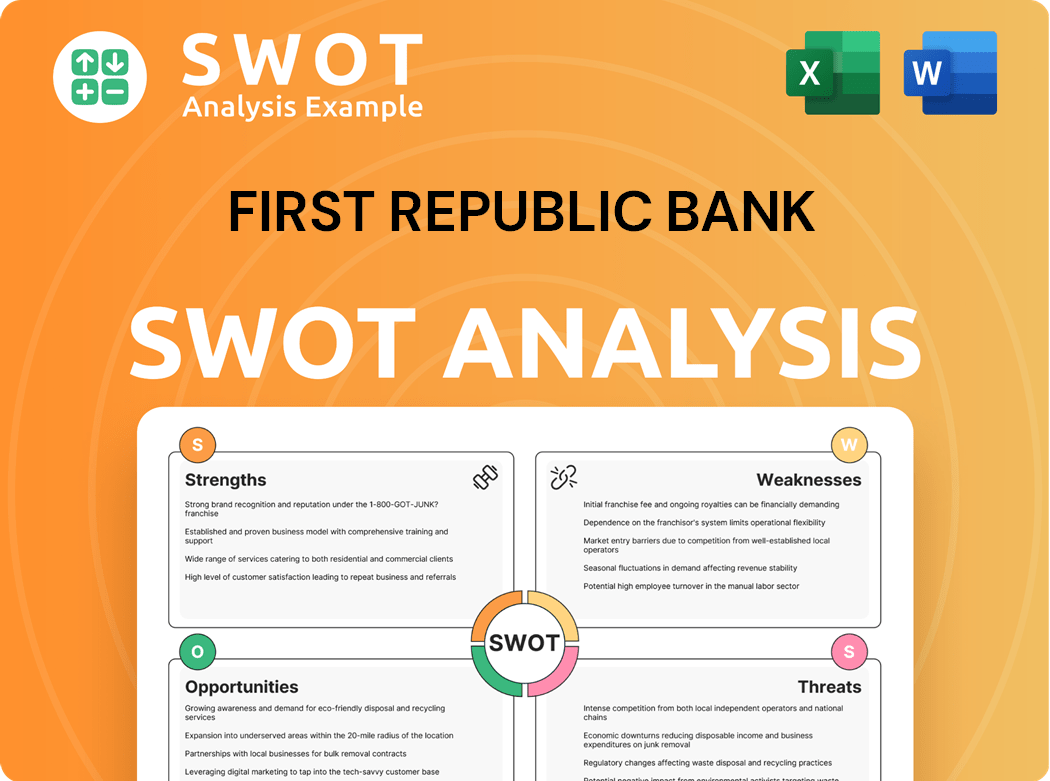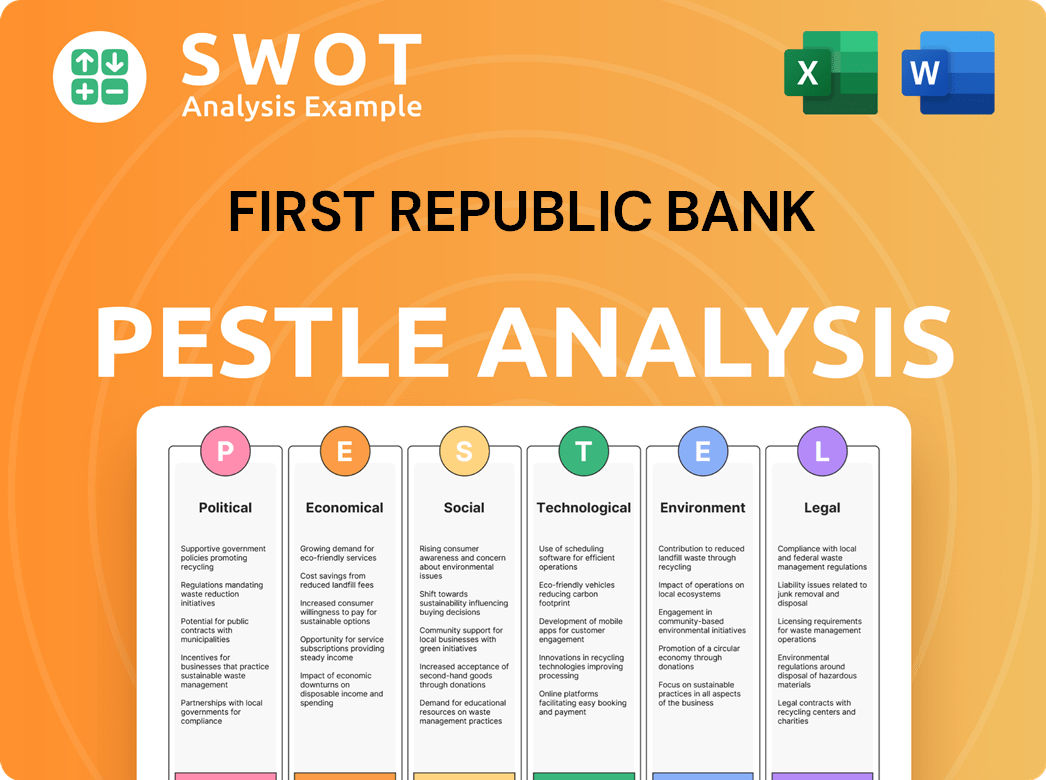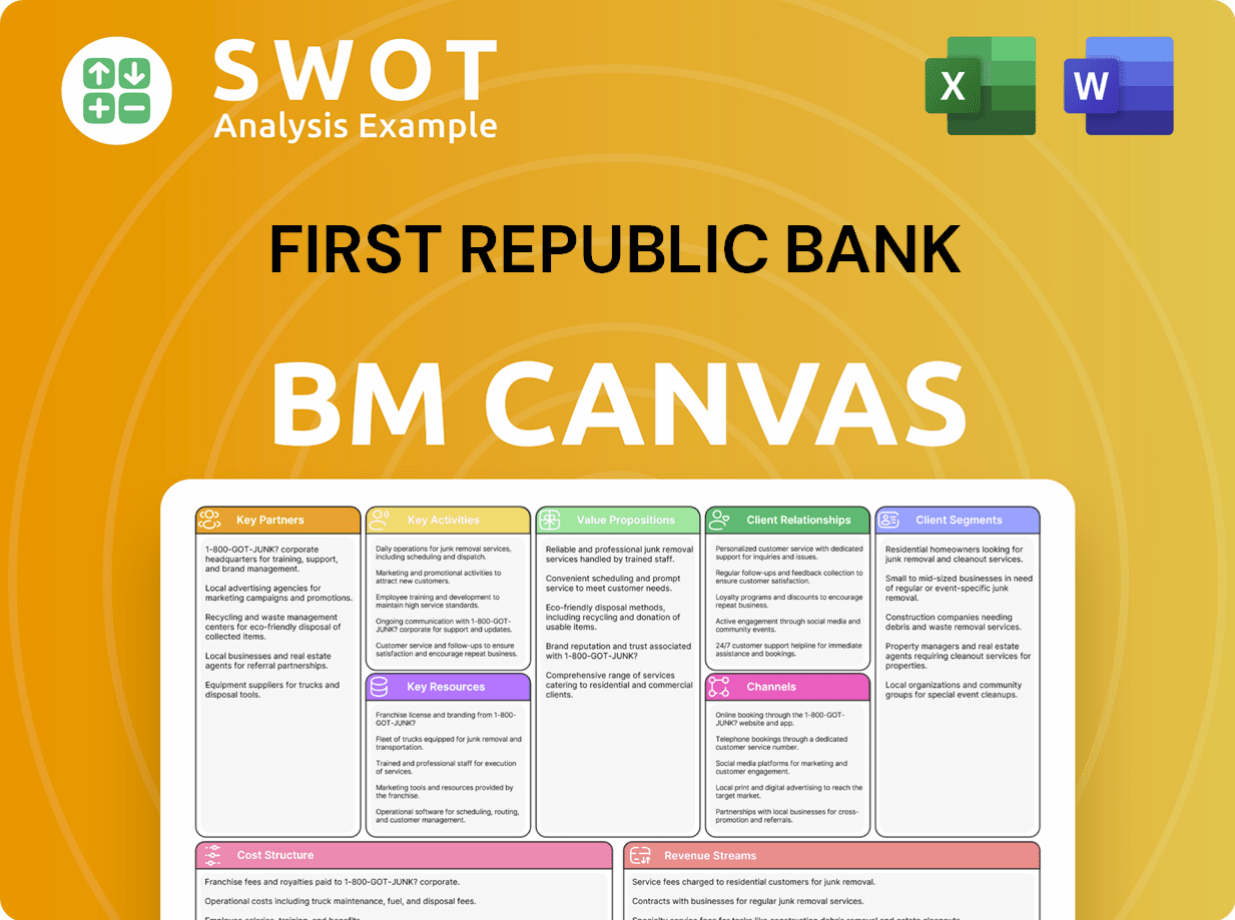First Republic Bank Bundle
What's the Story Behind First Republic Bank's Rise and Fall?
Founded in 1985, First Republic Bank (FRB) quickly became a darling of the banking industry, known for its personalized service to high-net-worth clients. From its humble beginnings in San Francisco, the bank experienced remarkable growth, expanding across the United States. But what caused this financial institution to ultimately meet a dramatic end?

This article delves into the brief history of First Republic Bank, tracing its journey from its founding to its acquisition by JPMorgan Chase. We'll explore the First Republic Bank SWOT Analysis, key events, and the factors that shaped its trajectory, offering insights into the bank's financial performance and the broader banking industry. Understanding the First Republic history provides valuable lessons for investors and business strategists alike, especially considering the First Republic Bank crisis and its eventual collapse.
What is the First Republic Bank Founding Story?
The story of First Republic Bank (FRB) began on February 5, 1985. It was founded by Jim Herbert, who previously led San Francisco Bancorp. His vision was to create a bank that catered to the specific financial needs of high-net-worth individuals, marking the start of the First Republic history.
The bank officially launched on July 1, 1985, as a California-chartered industrial loan company. Its initial strategy focused on providing private banking services. These included jumbo mortgages, Certificates of Deposit (CDs), and savings accounts. A key element was building personalized client relationships, setting it apart in the
First Republic Bank's early years were marked by strategic financial moves. The company went public through an initial public offering (IPO) on Nasdaq in August 1986. Shares were initially priced at $10 each. General Atlantic, an investment firm, became an early investor in 1987, contributing around $5 million. This early funding helped shape the trajectory of the
First Republic Bank's establishment and early growth reflect a strategic approach to serving a specific market segment.
- February 5, 1985: Founding of First Republic Bank by Jim Herbert.
- July 1, 1985: Official launch as a California-chartered industrial loan company.
- August 1986: IPO on Nasdaq at $10 per share.
- 1987: General Atlantic invests approximately $5 million.
First Republic Bank SWOT Analysis
- Complete SWOT Breakdown
- Fully Customizable
- Editable in Excel & Word
- Professional Formatting
- Investor-Ready Format

What Drove the Early Growth of First Republic Bank?
The early years of First Republic Bank, or FRB, were marked by significant growth and strategic expansion. From its inception, the financial institution focused on both organic growth and strategic acquisitions to broaden its offerings and geographical reach. By 2020, First Republic Bank had become one of the top 20 banks in the United States based on asset size, showcasing an impressive growth rate of approximately 25% annually over a period of 35 years.
A key development in the early growth of First Republic Bank involved expanding into new markets and product categories. In 1993, the bank acquired Silver State Thrift, a savings and loan association in Nevada, which was an early step in its geographical expansion. The bank aimed to transition to a banking charter in 1996 to broaden its service offerings, which led to lobbying efforts in the Nevada Legislature.
The bank continued its expansion through strategic acquisitions in the late 1990s and early 2000s, transforming into a full-service institution with a presence on both the West and East Coasts. These acquisitions, along with its focus on personalized service, enabled First Republic to build a strong reputation for serving a select, high-net-worth customer base. The market's reception to its specialized approach was largely positive, contributing to its sustained growth before the challenges of 2023.
In July 1997, a law was passed in the Nevada Legislature allowing the conversion of a Nevada thrift into a state bank. This facilitated the transformation of Silver State Thrift into First Republic Savings Bank through a reverse merger. Further acquisitions included Trainer Worthman & Co. in 1998, and Starbuck, Tisdale & Associates in December 2001 for $13 million in cash and stock. In January 2000, First Republic acquired an 18% interest in Froley, Revy Investment Company Inc., which it fully purchased in 2002 for $17 million in cash and stock.
To further enhance its wealth management capabilities, the bank acquired the Private Client Asset Management division of Bay Isle Financial from Janus Capital Group in 2004 and Bank of Walnut Creek in 2006. These strategic moves allowed First Republic Bank to establish a strong foothold in the wealth management sector. The bank's focus on personalized service and its ability to attract high-net-worth clients contributed to its significant growth in the financial institution.
First Republic Bank PESTLE Analysis
- Covers All 6 PESTLE Categories
- No Research Needed – Save Hours of Work
- Built by Experts, Trusted by Consultants
- Instant Download, Ready to Use
- 100% Editable, Fully Customizable

What are the key Milestones in First Republic Bank history?
The FRB company, throughout its history, achieved significant milestones, marked by strategic expansions and innovative service models, which positioned it as a prominent financial institution.
| Year | Milestone |
|---|---|
| 1985 | First Republic Bank was founded, focusing on personalized private banking services. |
| 2007 | Merrill Lynch acquired First Republic for $1.8 billion. |
| 2010 | First Republic was repurchased by a group of private investors, including its founder, and went public again in December 2010. |
| 2012 | Acquired Luminous Capital for $125 million. |
| 2015 | Acquired Constellation Wealth Partners for $115 million. |
| 2016 | Acquired the student loan debt startup Gradifi. |
| 2023 | First Republic Bank was seized by federal regulators and sold to JPMorgan Chase on May 1, 2023. |
A key innovation of First Republic was its dedication to personalized, relationship-based private banking and wealth management services for high-net-worth individuals and businesses. This included offering customized loan solutions and a comprehensive suite of wealth management services.
FRB company focused on building strong relationships with clients, offering tailored financial solutions. This approach distinguished it from competitors in the banking industry.
The bank provided a comprehensive suite of wealth management services, including investment management, brokerage, and trust services. This helped to attract and retain high-net-worth clients.
First Republic Bank offered customized loan solutions, such as low-interest jumbo mortgages. These were designed to meet the specific needs of their clientele.
The bank consistently received high ratings, being recognized as the 'Best Private Bank in North America' and a 'Top Family Bank'. This recognition enhanced its reputation.
First Republic Bank made strategic acquisitions to expand its service offerings and client base. These included Luminous Capital, Constellation Wealth Partners, and Gradifi.
The bank prioritized building strong relationships with its clients, which fostered loyalty and trust. This was a key differentiator in the competitive financial institution landscape.
Despite its successes, First Republic Bank faced significant challenges, particularly in 2023, leading to its collapse. The bank's reliance on uninsured deposits and a portfolio of low-interest, long-term assets made it vulnerable to interest rate risks and deposit outflows.
Following the failures of Silicon Valley Bank and Signature Bank in March 2023, First Republic experienced rapid deposit withdrawals. Customers pulled over $100 billion, leading to a liquidity crisis.
The bank's substantial portfolio of low-interest, long-term assets made it vulnerable to rising interest rates. This impacted the bank's financial performance.
First Republic's loan-to-deposit ratio was 111%, which exacerbated concerns about its financial stability. This high ratio indicated a reliance on borrowing to fund its lending activities.
A high proportion of uninsured deposits, 67.4% as of December 2022, increased the risk of large-scale withdrawals. This made the bank susceptible to a bank run.
The bank's stock plummeted by 75% in the week leading up to its collapse, with its market capitalization falling from $40 billion in November 2021 to below $0.6 billion. This reflected a loss of investor confidence.
On May 1, 2023, First Republic Bank was seized by federal regulators and sold to JPMorgan Chase. This marked the second-largest bank failure in US history after Washington Mutual in 2008.
First Republic Bank Business Model Canvas
- Complete 9-Block Business Model Canvas
- Effortlessly Communicate Your Business Strategy
- Investor-Ready BMC Format
- 100% Editable and Customizable
- Clear and Structured Layout

What is the Timeline of Key Events for First Republic Bank?
The First Republic Bank history is marked by significant events, starting with its founding in February 1985 by Jim Herbert. Initially operating as a California-chartered industrial loan company, it later went public in August 1986. Over the years, the FRB company expanded through acquisitions, including Silver State Thrift in 1993 and Trainer Worthman & Co. in 1998. A major shift occurred in September 2007 when Merrill Lynch acquired the bank, followed by its sale to private investors in July 2010, and a subsequent IPO in December 2010. The bank's trajectory took a decisive turn in March 2023, facing deposit outflows, and ultimately, it was closed by regulators and acquired by JPMorgan Chase on May 1, 2023. JPMorgan Chase plans to rebrand First Republic branches as J.P. Morgan wealth centers.
| Year | Key Event |
|---|---|
| February 1985 | First Republic Bank is founded by Jim Herbert in San Francisco, California. |
| August 1986 | Becomes a public company via an IPO on Nasdaq. |
| September 2007 | Acquired by Merrill Lynch for $1.8 billion. |
| July 2010 | Bank of America sells First Republic Bank to a group of private investors for approximately $1 billion, led by Jim Herbert. |
| May 1, 2023 | First Republic Bank is closed by regulators and acquired by JPMorgan Chase. |
| April 2024 | JPMorgan Chase announces that First Republic Bank branches will cease to exist under the First Republic name, with accounts converting to JPMorgan Chase over Memorial Day weekend 2024. |
JPMorgan Chase is integrating the First Republic Bank assets and client base into its wealth management strategy. The rebranding of branches to J.P. Morgan Financial Centers targets affluent clients, building on First Republic's prior focus. JPMorgan Chase is expanding its affluent banking presence by opening new centers. The acquisition is expected to be modestly EPS accretive.
JPMorgan Chase plans to open 14 new 'J.P. Morgan Financial Centers' in former First Republic locations in 2025, aiming to reach 31 by the end of 2026. The acquisition is projected to generate over $500 million of incremental net income annually, excluding one-time gains and restructuring costs. This expansion highlights JPMorgan Chase's commitment to the high-net-worth segment. The strategic move underscores a focus on growing its presence in the banking industry.
First Republic Bank Porter's Five Forces Analysis
- Covers All 5 Competitive Forces in Detail
- Structured for Consultants, Students, and Founders
- 100% Editable in Microsoft Word & Excel
- Instant Digital Download – Use Immediately
- Compatible with Mac & PC – Fully Unlocked

Related Blogs
- What is Competitive Landscape of First Republic Bank Company?
- What is Growth Strategy and Future Prospects of First Republic Bank Company?
- How Does First Republic Bank Company Work?
- What is Sales and Marketing Strategy of First Republic Bank Company?
- What is Brief History of First Republic Bank Company?
- Who Owns First Republic Bank Company?
- What is Customer Demographics and Target Market of First Republic Bank Company?
Disclaimer
All information, articles, and product details provided on this website are for general informational and educational purposes only. We do not claim any ownership over, nor do we intend to infringe upon, any trademarks, copyrights, logos, brand names, or other intellectual property mentioned or depicted on this site. Such intellectual property remains the property of its respective owners, and any references here are made solely for identification or informational purposes, without implying any affiliation, endorsement, or partnership.
We make no representations or warranties, express or implied, regarding the accuracy, completeness, or suitability of any content or products presented. Nothing on this website should be construed as legal, tax, investment, financial, medical, or other professional advice. In addition, no part of this site—including articles or product references—constitutes a solicitation, recommendation, endorsement, advertisement, or offer to buy or sell any securities, franchises, or other financial instruments, particularly in jurisdictions where such activity would be unlawful.
All content is of a general nature and may not address the specific circumstances of any individual or entity. It is not a substitute for professional advice or services. Any actions you take based on the information provided here are strictly at your own risk. You accept full responsibility for any decisions or outcomes arising from your use of this website and agree to release us from any liability in connection with your use of, or reliance upon, the content or products found herein.